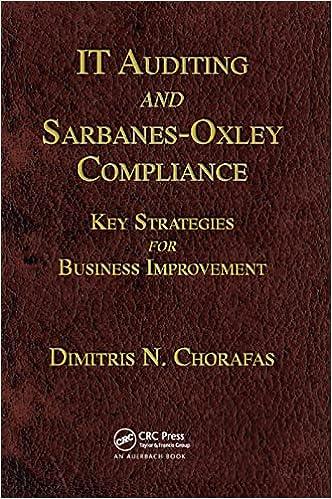Question
The Chester family owned and operated CEI, a manufacturer of electrical equipment. Mom and Dad Chester started the business. Their children grew up, became stockholders,
The Chester family owned and operated CEI, a manufacturer of electrical equipment. Mom and Dad Chester started the business. Their children grew up, became stockholders, and sat on the board of directors, which consisted entirely of family members. The youngest son, Matthew, was in charge of human resources and payroll. He hired employees, authorized factory time sheets, calculated the net pay for each employee, and took custody of the payroll checks from the outside firm that generated the physical paychecks for employees. Many of the factory workers were low-income immigrants who did not trust direct deposits for their paychecks. Matthew distributed paychecks to these employees himself. Matthews sister, Maisie, was the CFO of the company and a member of the Board of Directors. By accident one day, she detected a payroll fraud perpetrated by her brother. When reviewing the fronts and backs of canceled payroll checks, she noticed endorsements to her brother on the backs of some payroll checks. Further checking revealed many more of instances of endorsements. As a CPA herself, she became frightened because she knew the implications of fraud. She hired a CPA firm to do an audit and to uncover the extent of the fraud. A ghost, or fictitious, employee is someone who is on the payroll but who did not do work to earn the pay. When a ghost employee is paid, the money ends up in the hands of the fraudster. In this case, Matthew embezzled money from the family business by using ghost employees and stealing the checksa form of asset misappropriation. He did not remove terminated employees from the main table. In this manner, he created 344 ghost employees over time. He embezzled over $508,000 from the family business by creating more than 600 checks made out to ghost employees over a period of 8.5 years. He specifically targeted low-income immigrant workers who needed work and could not speak English well to be his ghost employees. Maisie reported the fraud to the board of directors. Upon seeing the audit evidence, Matthew confessed to the fraud and apologized profusely. Matthew had violated the trust placed in him by his family. His motivation was greed. Even though he was a shareholder in the business and earned a good salary, it was not enough for him. He saw the opportunity to commit payroll fraud, and he took it. All the family members on the board of directors, except for Maisie, accepted Matthews apology, circled the family wagon, and tried to sweep the fraud under the rug. Maisie, however, was scared. She realized that, while family owned, the company was a separate legal entity and that the fraud resulted in significant risks for the company. There were criminal implications for all involved, such as identity theft. The employees used as ghosts could sue the company, the business insurance could be canceled if the fraud was not addressed, and the companys reputation in the community could suffer harm. Employees suffered the consequences. The fictitious payroll payments of over $508,000 were included in the amounts reported to the state tax authorities and to the IRS. This created tax problems for the actual employees used as ghost employees. One employee, for example, was denied low-income housing because his income reported by the IRS to the housing authority was fraudulently overstated. Following the advice of the auditors, Maisie reported the fraud to the police. Matthew received a sentence of 23 months in prison and was ordered to pay back $508,000 as restitution. As he had not included his ill-gotten gains in his taxable income, he was also charged with filing false tax returns. This is something that fraudsters often forgetthey are required to declare and pay taxes on their ill-gotten gains! The fraud caused a huge rift in the family. Maisie, the whistleblower, became the family outcast.
Required:
1.Identify the internal control weaknesses that provided the opportunity for this fraud that split apart a family. 2.Suggest improvements in the process at CEI to reduce the risk of payments to fictitious employees.
Step by Step Solution
There are 3 Steps involved in it
Step: 1

Get Instant Access to Expert-Tailored Solutions
See step-by-step solutions with expert insights and AI powered tools for academic success
Step: 2

Step: 3

Ace Your Homework with AI
Get the answers you need in no time with our AI-driven, step-by-step assistance
Get Started


